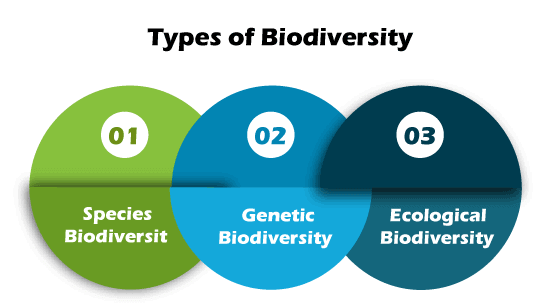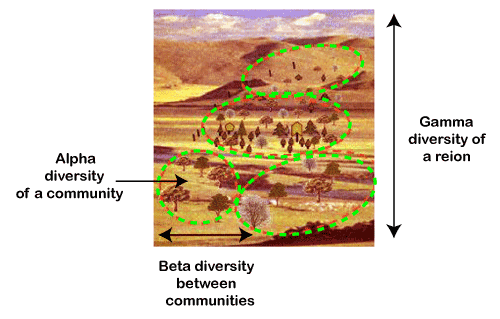Types of BiodiversityBiodiversity usually makes our planet beautiful, keeps the planet balanced, and helps it to function accordingly. In particular, biodiversity refers to the variability of life on Earth. As there are different types of biodiversity, perhaps the greatest value of biodiversity is yet unknown. Many of the Earth's biodiversity is disappearing at an increasingly alarming rate, even before we know what is missing. However, scientists and researchers worldwide are working on finding the actual cause and eliminating or slowing down the loss rate. Here, we are discussing the different types of biodiversity and their details. Before discussing the various biodiversity types, let us first get a quick overview of biodiversity with its definition and understand its importance. What is Biodiversity?Biodiversity, also called biological diversity, is one of the most complex and essential features of our planet (Earth). It describes the richness and diversity of life on Earth. It refers to the variability between plants, animals, and microorganism species. Life cannot exist without biodiversity. The biodiversity typically includes all terrestrial (land-dwelling), marine (aquatic), and many other ecosystems and ecological complexes. The term biodiversity was initially introduced in 1985. By definition, biodiversity refers to the variation among living organisms from distinct sources, including terrestrial, marine, and desert ecosystems and their ecological complexes. In other words, biodiversity can be defined as the total number of species of various animals, plants, fungi, and microbes living on Earth or in different habitats. 
Importance of BiodiversityBiodiversity is a crucial part of any ecosystem and plays a vital role in ecosystems' function and services. Different types of diversities help in maintaining the balance of nature. Therefore, biodiversity and its proper maintenance are so essential to sustaining life on the Earth. Some fundamental reasons that explain the importance of biodiversity are discussed below: Ecological StabilityEach species plays an essential role in an ecosystem. They typically capture and store the energy required for biological activities. Additionally, they produce and decompose organic materials in the ecosystem. The ecosystem includes many services necessary for humans to survive. Different species also have a relationship between the services provided by the ecosystem. Therefore, ecological stability results from a diverse, productive ecosystem and helps ecosystems withstand environmental stresses. Economic ImportanceBiodiversity is a storehouse of resources to manufacture food, cosmetic products, pharmacies, and more. Some rich resources of foods include crops, livestock, fishery, and forests. Various Wild plants (i.e., Cinchona, Foxglove, etc.) are good sources of pharmacies and can be used for medicinal purposes. Additionally, most resources such as wood, fiber, lubricants, resins, resins, poisons, and others also derive from various plant species. Ethical ImportanceSince all species have their roles in the ecosystem, everyone has the right to live. Human beings should not create problems for them and help them to survive. Human beings do not have the right to cause problems for the extinction of any species. Besides, biodiversity maintains the presence of different cultures and spiritual heritage and helps keep the balance between separate species. Thus, it is essential to conserve biodiversity. Types of BiodiversityThere are three essential types of biodiversity, which are listed below:

Let us discuss each in detail: What is Species Diversity?The species' diversity refers to a group of similar organisms that typically mate to produce offspring. They commonly share the same lineage. Species diversity is the most basic classification unit and includes all species ranging from plants to various microorganisms. Additionally, two different individuals from the same species group are also not exactly similar; they have diversity. For instance, two other human beings are not the same. Apart from this, people situated in entirely different regions have a significant level of diversity. As species diversity is seen in natural and agricultural ecosystems, the total numbers of different species of plants and animals located in an area form this type of diversity. It is believed that there are about 5-10 million species in the world; however, only 1.75 million of those species have been named scientifically so far on Earth. Some areas have more species than others. Areas with more species diversity are generally referred to as 'hotspots' of diversity. The more species found within the area, the more biodiverse the area is called, making the more biodiverse ecosystem. 
What is Genetic Diversity?It refers to differences between the genetic resources of organisms. Each individual of a particular species differs from the other in its genetic cons titution. That is why every human is different from another. Similarly, the species of rice, wheat, maize, barley, etc., have different varieties. Each member of any animal or plant species differs widely from other individuals in its genetic makeup because many combinations of genes are possible that give specific characteristics to each individual. This genetic variability is essential for the healthy reproduction of a species. Today, the diversity of nature is being exploited more by using wild relatives of crop plants to create new varieties of more productive crops and breed better domestic animals. Modern biotechnology manipulates genes to develop better types of drugs and a variety of industrial products. Although all species have come from a single or common ancestor, species diverge and produce new unique characteristics over time, thus contributing to biodiversity. 
What is Ecological Diversity?Ecological diversity is the complex network of different species present in local ecosystems and the dynamic interactions. An ecosystem consists of organisms of many several species living in a region and their connections through the flow of energy, nutrients, and matter. Those relationships occur as organisms of different species interact with each other. The primary source of energy in almost every ecosystem is the Sun. The radiant energy of the Sun is converted into chemical energy by plants. This energy flows from those systems when animals eat plants and are then consumed by other animals in return. Fungi get energy by decomposing organisms, which release nutrients back into the soil. Thus, an ecosystem comprises living components (microbes, plants, animals, and fungi) and non-living components (climate and chemicals) connected by energy flow and interact with each other. Ecological biodiversity is associated with plant and animal species living together and connected by the food chain and food webs. Diversity in various ecosystems, such as deserts, rainforests, mangroves, etc., also includes ecological diversity. It is generally observed between different ecosystems in a region. 
Ecological diversity has three major perspectives: the diversity of different species in a landscape is typically measured in three distinct scales. They are termed alpha diversity, beta diversity, and gamma diversity: Alpha DiversityAlpha diversity is the type of ecological diversity found within a specific region, community, or ecosystem. More specifically, alpha diversity refers to the species diversity within a community at a local scale or small scale, most often the size of one ecosystem. Generally, it is represented by the total number of different species (or species richness) in that particular region. This is often measured by the total number of taxa (distinct organism groups) within the corresponding ecosystem (species, genera, and families). In particular, if we think of diversity in an area, we refer to the alpha diversity more often than not. Beta DiversityBeta diversity refers to the type of ecological diversity measured by distinguishing the species diversity between different ecosystems or along with environmental gradients. The measurement of beta diversity typically involves comparing the number counts of taxa unique to each ecosystem. In simple words, it is the measure of species diversity between two separate entities at a larger scale, usually separated by a specific geographical barrier such as the mountain ridge or the river. It is the rate of change in species composition across habitats or among communities. Furthermore, beta diversity determines a quantitative measure of the diversity of communities that experience the changing environments. Gamma DiversityGamma diversity typically refers to all species richness over a large region (at a vast scale). It is the measure of the complete diversity for various distinct ecosystems within a region. In simple words, it is often studied as a biome where the species diversity is observed between several ecosystems. This usually ranges over the areas such as the whole mountain slope or the complete littoral zone of a seashore. Let us understand these three perspectives with the help of an example. Suppose an area of mountain slope is the landscape. The mountain slope usually contains various patches of grasslands and forests, as shown in the image below: 
Here, Alpha diversity refers to all such species diversity situated within every single grassland or forest patch of the slope. Beta diversity refers to all such species diversity located between any two patches and their corresponding communities. Lastly, the given landscape's Gamma diversity refers to all those species diversity present along with the entire range of the slope. Biodiversity in IndiaIndia is known as one of the most diverse countries worldwide. When it comes to the availability of different plant species, India is in ninth place amongst all countries' list. It is the origin of many important crop species, including cucumber, pigeon pea, sesame, eggplant, and cotton. Apart from this, India is one of the few nations producing a distinct range of domesticated species, including aromatic crops, legumes, medicinal, cereals, and vegetables. Two out of twenty-five biodiversity hotspots of the world are also situated in India. India is also known for its equally diverse faunal wealth. The nation has about 91,000 distinct range of animal species. However, there is a steady depletion in diversity, and to control this, various programs on biodiversity conservation are being launched from time to time. It is crucial to conserve nature to obtain necessary resources for sustainable development and derive benefits for present and future generations.
Next TopicEmail Marketing Tools
|
 For Videos Join Our Youtube Channel: Join Now
For Videos Join Our Youtube Channel: Join Now
Feedback
- Send your Feedback to [email protected]
Help Others, Please Share









